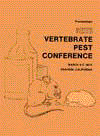Vertebrate Pest Conference: Proceedings

Vertebrate Pest Conference Proceedings: 6th (1974)
Date of this Version
March 1974
Document Type
Article
Abstract
Southern Africa is renowned for its wealth of animal life both in numbers and variety. Antelope in countless herds once roamed the plains , while the large mammals, the so-called big game, have drawn hunters to this continent from all over the world. Selected wildlife products such as ivory, rhino horn and skins have been articles of trade for centuries. But far more important, zoologically, is the fact that in this region representative of 51 families of mammals occurs, a greater variety than are to be found in any other zoo-geographical region. These are all placental mammals, and no monotremes or marsupials are bound here. The region is also characterized by the absence of bears, true deer, wild sheep* and goats. Another striking feature is that no less than 12 families are endemic, the most characteristic of which are the hoofed mammals. The antelopes from the major group of herbivorous mammals and probably the most remarkable component of the fauna of this region, numbering at least 30 species and ranging from the large eland (Taurotragus oryx) measuring two m at the shoulder and weighing 700 kg, to the diminutive and delicately built blue duiker (Cephalophus monticola). Although horses do not occur in the wild state, the fossilized remains of a true horse (Equus capensis) have been recorded. The family is, however, well represented by at least four species of zebra. From the viewpoint of this paper, however, the carnivores are the most important order and are also particularly well represented; in fact, the lion may be regarded as symbolic of the sub-continent. Representatives of the order include the civets, genets, mongooses, and meerkats; the honey-badger, otters, and weasels; the dog family such as jackals and hyenas; the large cat family, and that peculiar animal, the aardwolf (Proteles cristatus), which is endemic.

